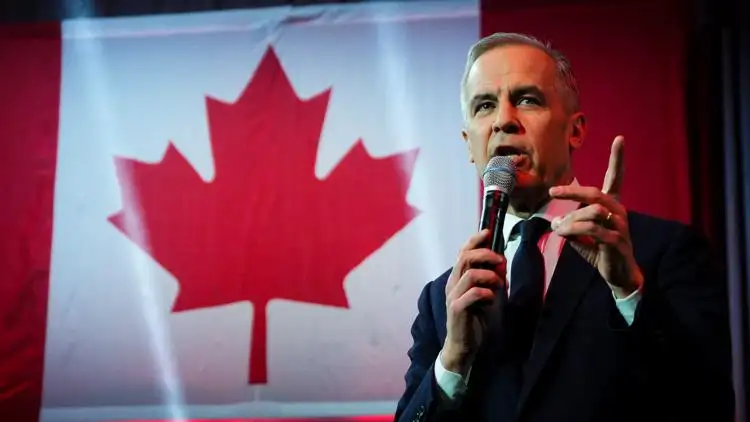Canada Election 2025: Who Is Mark Carney? Liberal Party Leader And Economist Poised To Become Prime Minister
In a major turn for Canadian politics, Mark Carney, a seasoned economist and former central bank governor, is now leading the Liberal Party into the 2025 federal election. Carney entered the political spotlight earlier this year after Justin Trudeau announced his resignation, ending nearly a decade of leadership. With his impressive background in economics and public service, Carney aims to guide Canada into its next chapter.

A New Era for the Liberal Party
Justin Trudeau’s departure in January 2025 created a leadership vacuum at the heart of Canadian politics. After months of speculation, Mark Carney officially announced his candidacy for the Liberal Party leadership — quickly gaining widespread support. His victory at the party convention signaled that Liberals sought an experienced, pragmatic figure to guide them into the future.
Carney’s reputation for competence and calm under pressure makes him a standout candidate in a year when many Canadians are seeking stability. His entry into politics wasn’t sudden; for years, people had mentioned him as a potential future leader, thanks to his high-profile roles on the global economic stage.
Who Is Mark Carney?
Born in Fort Smith, Northwest Territories, Carney grew up in Edmonton, Alberta. His early life in Canada’s heartland shaped his practical outlook and grounded his approach to leadership. After completing his undergraduate studies at Harvard University with a degree in economics, Carney earned further accolades, including a master’s degree and a doctorate in economics from the University of Oxford.
His professional career is equally impressive. Carney served as Governor of the Bank of Canada from 2008 to 2013, earning widespread praise for his handling of the global financial crisis. Under his leadership, Canada’s economy emerged relatively unscathed compared to many other countries. His performance caught international attention, leading to his appointment as Governor of the Bank of England in 2013 — the first non-British citizen ever to hold the post.
During his tenure in London, Carney stabilized the UK economy through turbulent times, including the fallout from Brexit. His ability to steer economies through unpredictable periods earned him widespread trust — a quality that now defines his political brand.
Transitioning from Economist to Politician
While Carney’s resume largely focuses on economic achievements, his transition into active politics marks a new chapter. Supporters argue that his expertise is exactly what Canada needs amid concerns about inflation, housing affordability, and global instability. Critics, however, question whether his technocratic style will resonate with everyday voters.
Carney seems aware of these challenges. In his campaign speeches, he emphasizes not just economic management but also social issues such as healthcare, climate change, and Indigenous reconciliation. “Canada’s strength lies in its people,” he said during his leadership launch event. “My goal is to build an economy that works for everyone — not just the privileged few.”
He has also worked to distance himself from any perception of elitism, often discussing his upbringing and early jobs, including working in the oil fields of Northern Canada during summers to help pay for his education.
Campaign Themes: Stability, Opportunity, and Climate Action
Carney’s campaign centers around three main pillars: economic stability, expanded opportunities for Canadians, and bold action on climate change. He has pledged to introduce policies that would increase housing supply, reform tax structures to ensure fairness, and invest heavily in green technology to meet Canada’s emissions targets.
His economic message focuses on addressing the cost-of-living crisis many Canadians face. “We can no longer afford a status quo where the next generation is priced out of homeownership and economic success feels out of reach,” he said at a recent town hall.
On the international front, Carney promises a Canada that remains open, principled, and proactive — a clear contrast to rising protectionist sentiment in other parts of the world.
A Challenging Road Ahead
Despite his impressive credentials, Carney faces significant challenges. The Conservative Party, under leader Pierre Poilievre, is mounting a fierce campaign centered on affordability and government accountability. Meanwhile, the New Democratic Party (NDP) continues to push for progressive policies that could siphon off Liberal voters on the left.
Carney’s relatively limited experience in electoral politics could also pose a hurdle. Running a political campaign differs vastly from managing central banks, and it remains to be seen whether Carney can connect with voters across Canada’s vast and diverse landscape.
Still, early polling suggests that many Canadians are intrigued by the idea of a leader who combines real-world economic expertise with a progressive vision for the future.
What’s Next?
As the election draws closer, all eyes are on Mark Carney and how he will translate his impressive resume into votes. His message of calm, competent leadership resonates in a political climate marked by uncertainty. If the Liberals manage to hold onto power, Carney could very well become Canada’s next Prime Minister — bringing with him a new style of leadership focused on long-term solutions rather than short-term politics.
For now, one thing is clear: Mark Carney’s entry into the race has transformed the landscape of Canadian politics, offering voters a distinct choice about the kind of future they want to build.






